Connect With Us
Blog
Blog
The Necessity and Benefits of Hammertoe Surgery

Hammertoe, a deformity characterized by an abnormal bending of the toe joint, can lead to discomfort, difficulty walking, and even pain during daily activities. While many cases of hammertoe can be managed with conservative measures such as padding, shoe modifications, and orthotic devices, surgery may be necessary in certain instances. Hammertoe surgery becomes essential when the condition progresses to a point where conservative treatments no longer provide relief or when the deformity interferes significantly with mobility and quality of life. During surgery, the surgeon may release tight tendons, reposition bones, or remove damaged tissue to straighten and realign the affected toe. Although surgery involves risks like any medical procedure, it can offer long-term relief and improve functionality for individuals suffering from severe hammertoe deformities. If you are living with hammertoe, it is strongly suggested that you are under the care of a podiatrist who can determine if surgery is the correct choice for you.
Foot surgery is sometimes necessary to treat a foot ailment. To learn more, contact Julie Jurd-Sadler, DPM of Progressive Podiatry. Our doctor will assist you with all of your foot and ankle needs.
When Is Surgery Necessary?
Foot and ankle surgery is generally reserved for cases in which less invasive, conservative procedures have failed to alleviate the problem. Some of the cases in which surgery may be necessary include:
- Removing foot deformities like bunions and bone spurs
- Severe arthritis that has caused bone issues
- Cosmetic reconstruction
What Types of Surgery Are There?
The type of surgery you receive will depend on the nature of the problem you have. Some of the possible surgeries include:
- Bunionectomy for painful bunions
- Surgical fusion for realignment of bones
- Neuropathy decompression surgery to treat nerve damage
Benefits of Surgery
Although surgery is usually a last resort, it can provide more complete pain relief compared to non-surgical methods and may allow you to finally resume full activity.
Surgical techniques have also become increasingly sophisticated. Techniques like endoscopic surgery allow for smaller incisions and faster recovery times.
If you have any questions please feel free to contact our offices located in Ijamsville and Mouth Airy, MD . We offer the newest diagnostic and treatment technologies for all your foot and ankle needs.
Causes and Symptoms of Cracked Heels
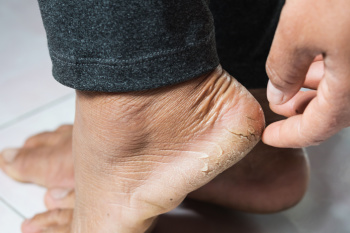
Cracked heels occur when the skin around the heels becomes dry, thickened, and fissured. This condition is often caused by a lack of moisture, leading to the skin's inability to retain hydration and elasticity. While anyone can develop cracked heels, some individuals are at a higher risk. Those who frequently expose their feet to harsh conditions, such as prolonged standing, walking barefoot, or wearing open-back shoes, are more susceptible. Additionally, factors like obesity, diabetes, and aging can contribute to the development of cracked heels. Symptoms of cracked heels include dryness, flakiness, redness, itching, and the formation of deep cracks or fissures. These fissures can be painful and may bleed in severe cases. It is essential to address cracked heels promptly to prevent complications such as infections. If you have developed cracked heels, it is strongly suggested that you consult a podiatrist who can provide the appropriate treatment methods.
Cracked heels are unsightly and can cause further damage to your shoes and feet. If you have any concerns, contact Julie Jurd-Sadler, DPM from Progressive Podiatry. Our doctor can provide the care you need to keep you pain-free and on your feet.
Cracked Heels
Cracked heels appear unappealing and can make it harder for you walk around in sandals. Aside from looking unpleasant, cracked heels can also tear stockings, socks, and wear out your shoes. There are several methods to help restore a cracked heel and prevent further damage.
How Do You Get Them?
Dry skin is the number one culprit in creating cracked heels. Many athletes, walkers, joggers, and even swimmers suffer from cracked heels. Age and skin oil production play a role to getting cracked heels as well.
Promote Healing
Over the counter medicines can help, especially for those that need instant relief or who suffer from chronic dry feet.
Wear Socks – Wearing socks with medicated creams helps lock in moisture.
Moisturizers – Applying both day and night will help alleviate dryness which causes cracking.
Pumice Stones – These exfoliate and remove dead skin, which allows for smoother moisturizer application and better absorption into the skin.
Change in Diet
Eating healthy with a well-balanced diet will give the skin a fresh and radiant look. Your body responds to the kinds of food you ingest. Omega-3 fatty acids and zinc supplements can also revitalize skin tissue.
Most importantly, seek professional help if unsure how to proceed in treating cracked heels. A podiatrist will help you with any questions or information needed.
If you have any questions, please feel free to contact our offices located in Ijamsville and Mouth Airy, MD . We offer the newest diagnostic and treatment technologies for all your foot care needs.
Understanding the Symptoms of Cuboid Syndrome
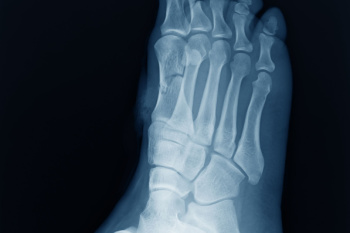
Cuboid syndrome, a relatively uncommon but painful condition, occurs when the cuboid bone in the foot becomes displaced or irritated, leading to discomfort and limited mobility. The cuboid bone is located on the outer side of the foot, near the middle, and plays an important role in maintaining foot stability and movement. Diagnosis of cuboid syndrome involves a thorough physical examination by a podiatrist, focusing on the foot's range of motion, tenderness, and specific movements that reproduce pain. Imaging tests such as X-rays or MRI scans may be utilized to rule out other potential causes of foot pain and confirm the diagnosis. Symptoms of cuboid syndrome typically include pain on the outer side of the foot, difficulty walking or bearing weight, swelling, and a sensation of instability or shifting in the midfoot area. In severe cases, manipulation or mobilization techniques by a podiatrist may be necessary to realign the cuboid bone and alleviate symptoms. If you have pain in this part of your foot, it is suggested that you visit a podiatrist who can successfully diagnose and treat cuboid syndrome.
Cuboid syndrome, also known as cuboid subluxation, occurs when the joints and ligaments near the cuboid bone in the foot become torn. If you have cuboid syndrome, consult with Julie Jurd-Sadler, DPM from Progressive Podiatry. Our doctor will assess your condition and provide you with quality foot and ankle treatment.
Cuboid syndrome is a common cause of lateral foot pain, which is pain on the outside of the foot. The condition may happen suddenly due to an ankle sprain, or it may develop slowly overtime from repetitive tension through the bone and surrounding structures.
Causes
The most common causes of cuboid syndrome include:
- Injury – The most common cause of this ailment is an ankle sprain.
- Repetitive Strain – Tension placed through the peroneus longus muscle from repetitive activities such as jumping and running may cause excessive traction on the bone causing it to sublux.
- Altered Foot Biomechanics – Most people suffering from cuboid subluxation have flat feet.
Symptoms
A common symptom of cuboid syndrome is pain along the outside of the foot which can be felt in the ankle and toes. This pain may create walking difficulties and may cause those with the condition to walk with a limp.
Diagnosis
Diagnosis of cuboid syndrome is often difficult, and it is often misdiagnosed. X-rays, MRIs and CT scans often fail to properly show the cuboid subluxation. Although there isn’t a specific test used to diagnose cuboid syndrome, your podiatrist will usually check if pain is felt while pressing firmly on the cuboid bone of your foot.
Treatment
Just as the range of causes varies widely, so do treatments. Some more common treatments are ice therapy, rest, exercise, taping, and orthotics.
If you have any questions, please feel free to contact our offices located in Ijamsville and Mouth Airy, MD . We offer the newest diagnostic and treatment technologies for all your foot care needs.
Hammertoe and Its Causes

Hammertoe is a foot deformity characterized by an abnormal bending of the toe joints, causing the affected toe to resemble a hammer or claw. This condition typically affects the second, third, or fourth toes. It results from an imbalance in the muscles, tendons, and ligaments that control toe movement. Tightening of the ligaments and tendons, often due to wearing ill-fitting shoes with narrow toe boxes or high heels, can force the toes into a bent position over time. Additionally, genetic predisposition, foot structure abnormalities, and underlying conditions like arthritis or nerve damage can contribute to the development of hammertoes. As the condition progresses, individuals may experience pain, discomfort, corns, or calluses on the affected toes, making it difficult to wear shoes comfortably. Early intervention through proper footwear, toe exercises, orthotic devices, and, in severe cases, surgical correction can help alleviate symptoms and prevent complications associated with hammertoe. If you have hammertoe, it is suggested that you seek guidance from a podiatrist for an appropriate diagnosis and management of this condition.
Hammertoes can be a painful condition to live with. For more information, contact Julie Jurd-Sadler, DPM of Progressive Podiatry. Our doctor will answer any of your foot- and ankle-related questions.
Hammertoe
Hammertoe is a foot deformity that occurs due to an imbalance in the muscles, tendons, or ligaments that normally hold the toe straight. It can be caused by the type of shoes you wear, your foot structure, trauma, and certain disease processes.
Symptoms
- Painful and/or difficult toe movement
- Swelling
- Joint stiffness
- Calluses/Corns
- Physical deformity
Risk Factors
- Age – The risk of hammertoe increases with age
- Sex – Women are more likely to have hammertoe compared to men
- Toe Length – You are more likely to develop hammertoe if your second toe is longer than your big toe
- Certain Diseases – Arthritis and diabetes may make you more likely to develop hammertoe
Treatment
If you have hammertoe, you should change into a more comfortable shoe that provides enough room for your toes. Exercises such as picking up marbles may strengthen and stretch your toe muscles. Nevertheless, it is important to seek assistance from a podiatrist in order to determine the severity of your hammertoe and see which treatment option will work best for you.
If you have any questions, please feel free to contact our offices located in Ijamsville and Mouth Airy, MD . We offer the newest diagnostic and treatment technologies for all your foot care needs.
Heel Pain Can Be Treated!
What Feet Can Reveal About Overall Health
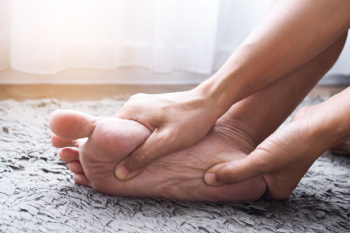
Feet, often overlooked, hold valuable clues about our overall health and well-being. Various signs and symptoms manifesting in the feet can serve as indicators of underlying health conditions. For instance, changes in skin color or texture may signify circulatory issues or skin disorders, while brittle or discolored toenails can hint at fungal infections or nutritional deficiencies. Swelling in the feet and ankles may be from fluid retention, heart problems, or kidney issues. Furthermore, nerve damage in the feet can be an early sign of conditions like diabetes or neuropathy. Additionally, foot pain and discomfort can result from musculoskeletal problems, arthritis, or wearing improper footwear. Regularly inspecting and caring for our feet can help detect potential health concerns early and facilitate timely intervention. By paying attention to the signals our feet convey, we can take proactive steps to safeguard our well-being and maintain optimal health. If you are experiencing any foot pain or discomfort, it is strongly suggested that you visit a podiatrist who can help you with relief and treatment solutions.
When dealing with systemic disease of the feet, it is extremely important to check the affected areas routinely so that any additional problems are caught quickly. If you have any concerns about your feet and ankles contact Julie Jurd-Sadler, DPM from Progressive Podiatry. Our doctor will assist you with all of your podiatric needs.
Systemic Diseases of the Feet
Systemic diseases affect the whole body, and symptoms usually are displayed in the feet. This condition can make a patient’s ability to walk unbearable. Systemic diseases include gout, diabetes mellitus, neurological disorders, and arthritis.
Gout – is caused by an excess of uric acid in the body. Common symptoms include pain, inflammation, and redness at the metatarsal/phalangeal joint of the base big toe. Gout can be treated by NSAIDs to relieve pain and inflammation, and other drugs that lower the acid levels in the body.
Diabetes mellitus – is an increase in the level of blood sugar that the body cannot counteract with its own insulin. Failure to produce enough insulin is a factor in Diabetes.
Diabetes of the Feet
Diabetic Neuropathy – may lead to damaged nerves and affect the feet through numbness and loss of sensation.
Peripheral Vascular Disease – can restrict the blood flow to the feet, and often times lead to amputation of the feet.
If you have any questions please feel free to contact our offices located in Ijamsville and Mouth Airy, MD . We offer the newest diagnostic and treatment technologies for all your foot and ankle needs.
Pain Caused by Working on Your Feet

If you are experiencing foot pain after a long day on your feet at work, you are not alone. The fatigue from standing all day can lead to discomfort, but if the foot pain persists, it may indicate more serious issues such as plantar fasciitis or heel spurs. Several factors contribute to foot pain and fatigue after working, including having inadequate support in your shoes, particularly if you are on hard surfaces like concrete or tile. Uneven pressure distribution within the foot and poor circulation can make the problem worse, leading to swelling and further discomfort. Additionally, existing foot conditions like bunions and Morton’s neuroma can intensify the pain. To alleviate foot pain after work, consider investing in supportive footwear with cushioned soles, taking breaks to stretch and walk, and wearing compression socks if circulation is an issue. Incorporating foot exercises and stretches into your daily routine can also help improve foot strength and flexibility, reducing the likelihood of pain. If foot pain persists, it is suggested that you schedule an appointment with a podiatrist for proper diagnosis and treatment options.
While working on the feet, it is important to take the proper care of them. For more information about working on your feet, contact Julie Jurd-Sadler, DPM from Progressive Podiatry. Our doctor will treat your foot and ankle needs.
Working on Your Feet
Standing on your feet for long periods of time can cause stress and pain in your feet. Your whole body may experience change in terms of posture, back pain, bunions, callouses and or plantar warts. There are ways to avoid these conditions with proper foot care, smart choices and correct posture.
Positive Changes
Negative heeled shoe – Choosing this shoe type places the heel slightly lower than the ball of the foot. These are great for overall foot health. Find shoes that fit you correctly.
Go barefoot – Our feet were not designed to be enclosed for all hours of the day. Try to periodically expose your feet to air.
Eliminate Pain
Foot Exercises – Performing simple exercises, incorporating yoga and doing stretches are beneficial. This will allow increased blood flow to the area and muscles of the foot.
Achilles tendon – Stretching the foot out flat on the floor will relax the calf muscles and tendon. These exercises can be performed almost anywhere. Make sure you add these exercises to your daily regimen.
With a little bit of this information and knowing more about foot health, you will notice changes. Foot stretches and proper footwear will help with pain and prevent further issues.
If you have any questions please feel free to contact our offices located in Ijamsville and Mouth Airy, MD . We offer the newest diagnostic and treatment technologies for all your foot and ankle needs.
Possible Foot Problems From Wearing High Heels
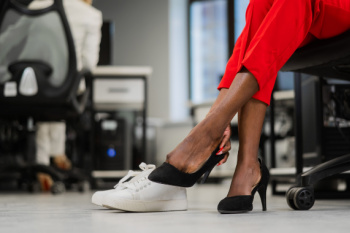
High heels, while fashionable, can lead to various foot problems due to their design and the way they alter the natural mechanics of walking. One common issue is the development of bunions, where the pressure and narrow toe box of high heels force the big toe to bend outward, causing a painful bony bump to form. Additionally, wearing high heels regularly can shorten the Achilles tendon and calf muscles, leading to stiffness and discomfort when walking in flat shoes. High heels also increase pressure on the ball of the foot, potentially causing metatarsalgia, a painful condition characterized by inflammation and discomfort in the ball of the foot. Furthermore, the instability caused by high heels can contribute to ankle sprains and instability over time. To mitigate these issues, it is important to limit high heel wear, opt for lower, wider heels when possible, and incorporate foot-strengthening exercises into your routine to counteract the negative effects of high heels on foot health. If you wear high heels and have developed specific foot conditions, it is suggested that you consult a podiatrist who can effectively treat any foot ailment that has arisen, and offer other footwear choices.
High heels have a history of causing foot and ankle problems. If you have any concerns about your feet or ankles, contact Julie Jurd-Sadler, DPM from Progressive Podiatry. Our doctor can provide the care you need to keep you pain-free and on your feet.
Effects of High Heels on the Feet
High heels are popular shoes among women because of their many styles and societal appeal. Despite this, high heels can still cause many health problems if worn too frequently.
Which Parts of My Body Will Be Affected by High Heels?
- Ankle Joints
- Achilles Tendon – May shorten and stiffen with prolonged wear
- Balls of the Feet
- Knees – Heels cause the knees to bend constantly, creating stress on them
- Back – They decrease the spine’s ability to absorb shock, which may lead to back pain. The vertebrae of the lower back may compress.
What Kinds of Foot Problems Can Develop from Wearing High Heels?
- Corns
- Calluses
- Hammertoe
- Bunions
- Morton’s Neuroma
- Plantar Fasciitis
How Can I Still Wear High Heels and Maintain Foot Health?
If you want to wear high heeled shoes, make sure that you are not wearing them every day, as this will help prevent long term physical problems. Try wearing thicker heels as opposed to stilettos to distribute weight more evenly across the feet. Always make sure you are wearing the proper shoes for the right occasion, such as sneakers for exercising. If you walk to work, try carrying your heels with you and changing into them once you arrive at work. Adding inserts to your heels can help cushion your feet and absorb shock. Full foot inserts or metatarsal pads are available.
If you have any questions please feel free to contact our offices located in Ijamsville and Mouth Airy, MD . We offer the newest diagnostic and treatment technologies for all your foot and ankle needs.
What Causes Cracked Heels?
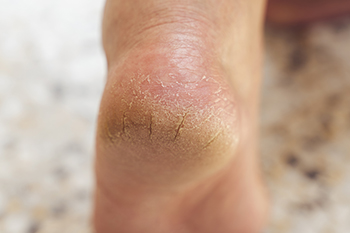
Cracked heels, a common foot ailment, can be traced back to various factors that contribute to their unsightly appearance and discomfort. Inadequate moisturization emerges as a primary culprit, as neglecting to keep the skin hydrated can lead to dryness and fissures. Prolonged standing or walking on hard surfaces exerts excessive pressure on the heels, causing them to crack. Wearing ill-fitting shoes exacerbates the issue, rubbing against the skin and creating friction that weakens the natural barrier. Additionally, exposure to harsh weather conditions, such as extreme heat or cold, can strip the skin of its moisture, making it prone to cracking. Poor foot hygiene and improper foot care practices may further contribute to the development of cracked heels. Cracked heels can be painful, and if you have developed this condition, it is suggested that you confer with a podiatrist who can prescribe medication for effective relief.
If the skin on your feet starts to crack, you may want to see a podiatrist to find treatment. If you have any concerns, contact Julie Jurd-Sadler, DPM from Progressive Podiatry. Our doctor can provide the care you need to keep you pain-free and on your feet.
Cracked Heels
It is important to moisturize your cracked heels in order to prevent pain, bleeding, and infection. The reason cracked heels form is because the skin on the foot is too dry to support the immense pressure placed on them. When the foot expands, the dry skin on the foot begins to split.
Ways to Help Heal Them
- Invest in a good foot cream
- Try Using Petroleum Jelly
- Ease up on Soaps
- Drink Plenty of Water
Ways to Prevent Cracked Heels
- Moisturize After Showering
- Skip a Shower
- Keep Shower Water Lukewarm
- Don’t Scrub Your Feet
If you are unsure how to proceed in treating cracked heels, seek guidance from a podiatrist. Your doctor will help you with any questions or information you may need.
If you have any questions, please feel free to contact our offices located in Ijamsville and Mouth Airy, MD . We offer the newest diagnostic and treatment technologies for all your foot care needs.
Plantar Warts Can Be Treated!
More...
Managing a Stubbed Toe
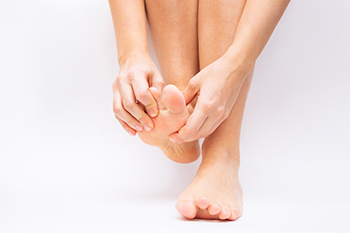
Managing a stubbed toe can be a surprisingly painful experience. Stubbing a toe often results from accidentally kicking the toe into a wall, tripping over objects, or catching it on various surfaces. The symptoms, whether the injury is minor or severe, typically include intense and sometimes sharp pain, radiating discomfort through the foot or ankle, and pain when putting weight on the injured area. The pain of stubbed toes can be significant because of the abundance of nerves in the toe. This heightened sensitivity is compounded by the lack of substantial cushioning in some shoes, along with minimal fat in the toe to absorb impact. This can increase the risk of more severe injuries, such as bone bruises and fractures. If the toe begins to swell and persistent pain lingers even after several hours, it is a sign you may need to see a podiatrist. Additionally, if the toenail either detaches, or the surrounding area experiences significant swelling, you may be at risk of an infection. For these reasons, it is suggested that you schedule an appointment with a podiatrist to ensure proper care and prevent potential complications.
Toe pain can disrupt your daily activities. If you have any concerns, contact Julie Jurd-Sadler, DPM of Progressive Podiatry. Our doctor can provide the care you need to keep you pain-free and on your feet.
What Causes Toe Pain?
Most severe toe pain is caused due to a sports injury, trauma from dropping something heavy on the toe, or bumping into something rigid. Other problems can develop over time for various reasons.
Toe pain can be caused by one or more ailments. The most common include:
- Trauma
- Sports injury
- Wearing shoes that are too tight
- Arthritis
- Gout
- Corns and calluses
- Hammertoe
- Bunions
- Blisters
- Ingrown toenails
- Sprains
- Fractures (broken bones)
- Dislocations
When to See a Podiatrist
- Severe pain
- Persistent pain that lasts more than a week
- Signs of infection
- Continued swelling
- Pain that prevents walking
Diagnosis
In many cases the cause of toe pain is obvious, but in others, a podiatrist may want to use more advanced methods to determine the problem. These can range from simple visual inspections and sensation tests to X-rays and MRI scans. Prior medical history, family medical history, and any recent physical traumatic events will all be taken into consideration for a proper diagnosis.
Treatment
Treatments for toe pain and injuries vary and may include shoe inserts, padding, taping, medicines, injections, and in some cases, surgery. If you believe that you have broken a toe, please see a podiatrist as soon as possible.
If you have any questions please feel free to contact our offices located in Ijamsville and Mouth Airy, MD . We offer the newest diagnostic tools and technology to treat your foot and ankle needs.
Suitable Shoes for Walking and Running

When it comes to choosing between running and walking shoes, understanding the key differences can make all the difference. Both walkers and runners have distinct footwear needs, and these needs are reflected in the design of their shoes. The important factors to consider include shoe weight, cushioning, and flexibility. Running shoes are typically lightweight, facilitating quick movements, while walking shoes are generally heavier to provide stability and support during a slower, consistent pace. Running shoes offer more cushioning in the forefoot and heel to absorb the impact of continuous running strides. Walkers require good foot support over extended periods. Running shoes are more flexible in the midfoot or arch, accommodating the runner's constant strike at their midfoot or the ball of their foot. Additionally, walkers need arch flexibility since they rely on their toes to push off. Regardless of your choice, monitor how your shoes support your needs during your walk, and remember to replace them after every 300 to 400 miles or every four to six months to maintain optimal comfort and prevent injury. If you need help in determining what the right shoes are for running or walking, it is suggested that you consult with a podiatrist who is an expert in feet and ankle knowledge.
For more information about walking shoes versus running shoes, consult with Julie Jurd-Sadler, DPM from Progressive Podiatry. Our doctor can measure your feet to determine what your needs are and help you find an appropriate pair of footwear.
Foot Health: The Differences between Walking & Running Shoes
There are great ways to stay in shape: running and walking are two great exercises to a healthy lifestyle. It is important to know that running shoes and walking shoes are not interchangeable. There is a key difference on how the feet hit the ground when someone is running or walking. This is why one should be aware that a shoe is designed differently for each activity.
You may be asking yourself what the real differences are between walking and running shoes and the answers may shock you.
Differences
Walking doesn’t involve as much stress or impact on the feet as running does. However, this doesn’t mean that you should be any less prepared. When you’re walking, you land on your heels and have your foot roll forward. This rolling motion requires additional support to the feet.
Flexibility – Walking shoes are designed to have soft, flexible soles. This allows the walker to push off easily with each step.
If you have any questions, please feel free to contact our offices located in Ijamsville and Mouth Airy, MD . We offer the newest diagnostic and treatment technologies for all your foot care needs.
Persistent Foot Pain
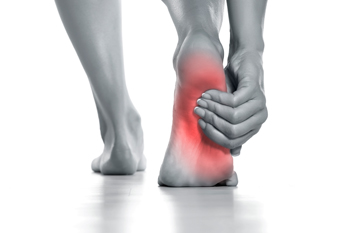
Your feet play a vital role in your daily life, enduring substantial wear and tear. It is estimated that by the age of 50, you will have covered approximately 75,000 miles on your feet alone. Given this extensive use and the intricate nature of the feet, it is highly probable that you will encounter various foot-related issues over time. The most frequent causes of foot and ankle pain are short-term and result from soft tissue injuries, such as sprains or strains, which typically resolve in a few months. However, persistent or worsening pain may be indicative of structural changes within the foot or ankle or it may indicate an underlying condition. Factors contributing to long-term discomfort include ill-fitting footwear, osteoarthritis, inflammatory arthritis, connective tissue disorders, poor circulation, and nerve damage. If you have continuing foot pain, it is suggested that you schedule an appointment with a podiatrist for a diagnosis and tailored treatment options.
Foot Pain
Foot pain can be extremely painful and debilitating. If you have a foot pain, consult with Julie Jurd-Sadler, DPM from Progressive Podiatry. Our doctor will assess your condition and provide you with quality foot and ankle treatment.
Causes
Foot pain is a very broad condition that could be caused by one or more ailments. The most common include:
- Bunions
- Hammertoes
- Plantar Fasciitis
- Bone Spurs
- Corns
- Tarsal Tunnel Syndrome
- Ingrown Toenails
- Arthritis (such as Gout, Rheumatoid, and Osteoarthritis)
- Flat Feet
- Injury (from stress fractures, broken toe, foot, ankle, Achilles tendon ruptures, and sprains)
- And more
Diagnosis
To figure out the cause of foot pain, podiatrists utilize several different methods. This can range from simple visual inspections and sensation tests to X-rays and MRI scans. Prior medical history, family medical history, and any recent physical traumatic events will all be taken into consideration for a proper diagnosis.
Treatment
Treatment depends upon the cause of the foot pain. Whether it is resting, staying off the foot, or having surgery; podiatrists have a number of treatment options available for foot pain.
If you have any questions, please feel free to contact our offices located in Ijamsville and Mouth Airy, MD . We offer the newest diagnostic and treatment technologies for all your foot care needs.
A Look at Foot and Ankle Conditions in Young Athletes

As young athletes embark on their journey in sports, the health of their feet and ankles becomes paramount to their overall well-being and performance. The developing musculoskeletal system of young individuals is more susceptible to various conditions that can impact their mobility and athletic prowess. Common issues include Sever's disease, an inflammation of the growth plate in the heel, and Osgood-Schlatter disease, which affects the growth plate at the top of the shinbone. Sprained ankles, often incurred during high-impact activities, require prompt attention to prevent lingering complications. Additionally, stress fractures, a result of repetitive strain on the bones, can affect young athletes pushing their physical limits. It is vital for parents, coaches, and young athletes alike to be aware of these conditions, emphasizing the significance of wearing proper footwear and getting adequate rest. If your active child has developed a foot or ankle condition, it is suggested that you confer with a podiatrist who can offer the appropriate treatment methods.
Sports related foot and ankle injuries require proper treatment before players can go back to their regular routines. For more information, contact Julie Jurd-Sadler, DPM of Progressive Podiatry. Our doctor can provide the care you need to keep you pain-free and on your feet.
Sports Related Foot and Ankle Injuries
Foot and ankle injuries are a common occurrence when it comes to athletes of any sport. While many athletes dismiss the initial aches and pains, the truth is that ignoring potential foot and ankle injuries can lead to serious problems. As athletes continue to place pressure and strain the area further, a mild injury can turn into something as serious as a rupture and may lead to a permanent disability. There are many factors that contribute to sports related foot and ankle injuries, which include failure to warm up properly, not providing support or wearing bad footwear. Common injuries and conditions athletes face, including:
- Plantar Fasciitis
- Plantar Fasciosis
- Achilles Tendinitis
- Achilles Tendon Rupture
- Ankle Sprains
Sports related injuries are commonly treated using the RICE method. This includes rest, applying ice to the injured area, compression and elevating the ankle. More serious sprains and injuries may require surgery, which could include arthroscopic and reconstructive surgery. Rehabilitation and therapy may also be required in order to get any recovering athlete to become fully functional again. Any unusual aches and pains an athlete sustains must be evaluated by a licensed, reputable medical professional.
If you have any questions please feel free to contact our offices located in Ijamsville and Mouth Airy, MD . We offer the newest diagnostic and treatment technologies for all your foot and ankle needs.
Blog Archives
- April 2025
- March 2025
- February 2025
- January 2025
- December 2024
- November 2024
- October 2024
- September 2024
- August 2024
- July 2024
- June 2024
- May 2024
- April 2024
- March 2024
- February 2024
- January 2024
- December 2023
- November 2023
- October 2023
- September 2023
- August 2023
- July 2023
- June 2023
- May 2023
- April 2023
- March 2023
- February 2023
- January 2023
- December 2022
- November 2022
- October 2022
- September 2022
- August 2022
- July 2022
- June 2022
- May 2022
- April 2022
- March 2022
- February 2022
- January 2022
- December 2021
- November 2021
- October 2021
- September 2021
- August 2021
- July 2021
- June 2021
- May 2021
- April 2021
- March 2021
- February 2021
- January 2021
- December 2020
- November 2020
- October 2020
- September 2020
- August 2020
- July 2020
- June 2020
- May 2020
- April 2020
- March 2020
- February 2020
- January 2020
- December 2019
- November 2019


